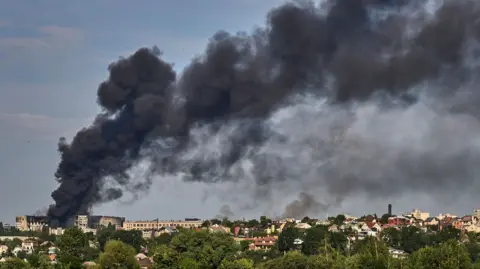On June 7, 2025, Kharkiv, Ukraine’s second-largest city, experienced one of the most significant drone strikes in the ongoing conflict with Russia. This severe attack left a tragic toll of three individuals dead and at least 21 others injured. The mayor of Kharkiv, Ihor Terekhov, reported that the assault involved a staggering barrage of 48 drones, complemented by two missiles and four gliding bombs, characterizing the assault as “open terror.”
The drone strike on Kharkiv was part of a larger wave of offensive actions launched by Russia against Ukraine. Earlier in the week, Ukraine had conducted its own unexpected raids on Russian air bases, provoking retaliatory strikes. Moscow claimed its actions were necessary in response to what it termed “terrorist attacks” orchestrated by the Ukrainian government. This escalation highlights the deeply entrenched hostilities that have characterized the Russo-Ukrainian war since its inception in February 2022.
During the night’s operation, 18 residential buildings and 13 additional homes in Kharkiv faced direct hits. Among the injured were a baby and a 14-year-old girl, which underscores the indiscriminate nature of the air strikes and their devastating impact on civilian life. Furthermore, Kharkiv’s governor, Oleh Syniehubov, indicated that a civilian industrial facility was targeted, resulting in extensive structural damage, with fears that individuals could be trapped under the debris.
The violence didn’t stop in Kharkiv. Local authorities in Kherson, a city in southeastern Ukraine, reported that two civilians were killed due to Russian shelling. Ukrainian Foreign Minister Andriy Sybiha responded to these attacks by calling upon international allies to amplify their pressure on Moscow and to enhance military support for Ukraine. The urgency of his appeal is evident as the previous night, more than 400 drones and nearly 40 missiles were launched against various targets across Ukraine, resulting in six fatalities and 80 injuries.
In this current phase of the conflict, diplomatic exchanges between Russian and Ukrainian officials have produced contrasting accounts regarding the timing and conditions of a prisoner swap, which has been a significant aspect of discussions aimed at alleviating some of the tensions between the two nations. While both sides previously reached an agreement to exchange sick, severely wounded prisoners and the bodies of deceased soldiers, the execution of these negotiations has faced obstacles, leading to mutual accusations of bad faith.
The deterioration of these diplomatic discussions reverberates with the intensity of the recent military actions. Ukrainian President Volodymyr Zelensky expressed his view that Russian President Vladimir Putin is stalling, seemingly to perpetuate the conflict further. Such sentiments reflect Ukraine’s frustration with the stalled negotiation processes and the ongoing violence.
In the wake of the drone strikes, Ukraine’s security service, the SBU, revealed that it had executed an audacious operation dubbed “Operation Spider’s Web,” targeting various Russian air bases. According to Ukrainian sources, this operation utilized 117 drones that had been smuggled into Russia, demonstrating an innovative approach to conducting strikes deep within enemy territory. This bold maneuver signals a potential shift in the war dynamics, emphasizing Ukraine’s evolving military capabilities.
Despite the ongoing strife, peace talks that could potentially pave the way for a ceasefire have yet to gain traction. Both nations remain at an impasse regarding fundamental issues that need to be resolved for any meaningful resolution of the conflict. Ukraine seeks an “unconditional ceasefire,” which Russia has persistently rebuffed.
As the conflict rages on, the humanitarian toll and the devastation of infrastructure continue to escalate. The international community watches closely as Kyiv and Moscow navigate their tenuous trajectory, balancing diplomacy with warfare. The situation remains fluid, and the need for renewed efforts to reach a sustainable peace agreement becomes increasingly critical.



